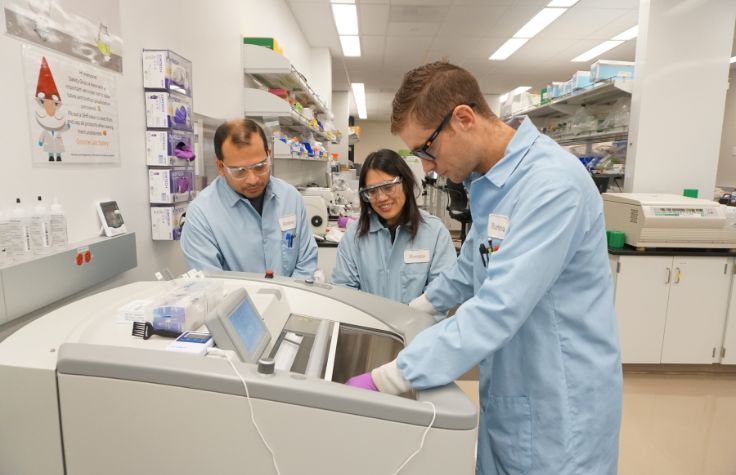
29 September 2025
Tia Hansen’s father loved being in the mountains. But his pulse became erratic with exertion. He started feeling lightheaded and experienced some fainting episodes on the trail. He was diagnosed with long QT syndrome, or LQTS, a condition in which the heart muscle takes longer than it should to recover after each beat. People who have it carry a higher risk of sudden cardiac arrest. Tia was 11 years old at the time.
Despite not experiencing any symptoms, Tia and her younger brothers all had genetic testing done—and it turned out that three of them had LQTS as well. But the diagnosis gave them direction and a plan. Equipped with that knowledge, they could find the right electrophysiologist, who knew the right medications to prescribe and lifestyle changes to recommend.
What does it mean to have a “long QT interval”?
An electrocardiogram’s characteristic squiggle records the heart’s electrical activity: The small dip before the big spike is the Q wave, when the ventricles begin depolarizing; the gentle curve after the big spike is the T wave, when the ventricles repolarize. The time between the Q and T waves is the QT interval, and if that interval takes too long, it can cause fainting and sudden cardiac arrest.
Fast forward to 2024. Tia’s father had been having even more frequent and severe symptoms, to the point that his cardiologist suspected something more than LQTS was to blame. He received further genetic testing and learned that he has a second condition: hypertrophic cardiomyopathy, or HCM.
HCM thickens the cardiac muscle and makes it more difficult for the heart to pump. One of his doctors estimated that less than one percent of his patients have both conditions—although HCM is also genetic and presents similar symptoms as LQTS, it affects the actual structure of the heart, not just its activity. Tia suspects that the cardiologist who made her father’s original diagnosis may not even have thought to check for it.
She and her siblings had the same test done and learned that—again, despite showing no symptoms—they were carriers for HCM too. So they took action to get the right care. The siblings treat their conditions effectively with beta blocker medications, which help slow their heart rate, reduce blood pressure, and block adrenaline to keep their hearts in a safe rhythm. Their dad received an implantable cardioverter-defibrillator, a tiny device similar to a pacemaker that delivers an electric shock to restore a normal heart rhythm when it detects an abnormal one.
Genetic testing has consistently helped the whole family stay one step ahead. Tia says, “Getting these answers, so we can move forward and not only have peace of mind, but know what to look for, has been a huge blessing in my life.”

As a family support coordinator for the SADS Foundation, Tia Hansen helps people find the right testing, counseling, and health care. | Photo by Sandra Salvas
The next generation of preventive care
When Tia was ready to start having children of her own, she knew she had a 50-50 chance of passing LQTS on to them. “It was such a mixed feeling,” she says. “Part of me was like, okay, I’m going to be sad if they have it, but grateful that I can get an answer basically right away.”
And she did. Before each of her three children were a month old, she had them tested for LQTS. And all of them had indeed inherited it. But this time, the family was prepared and could begin preventive care right from infancy.
“We’ve all done great and have had a healthy life,” she says. Mom and Dad are on top of it, keeping the kids on their medication and staying in frequent contact with their school nurse and cardiologist. “They’re really thriving. They really are active, happy, healthy kids; we just need to be aware of what we have.” In fact, her kids have no restrictions on their activity. “My daughter is on a dance team; she does competitions and is always dancing. And my son has played every sport; he even races dirt bikes.”

"They really are active, happy, healthy kids; we just need to be aware of what we have." | Photo by Sandra Salvas
Paying it forward and becoming an advocate
Geneticists at the University of Utah have been studying LQTS since the early 1970s, and were the first to identify the gene responsible for it, in 1991. That year, Dr. G. Michael Vincent and his colleagues established the Sudden Arrhythmia Death Syndromes (SADS) Foundation, to increase awareness of this and similar conditions and provide support to people affected by them.
Tia earned her degree in community health, and one of her career goals in college was to someday join the SADS Foundation. After working in the cardiology industry for eight years, she finally realized that goal in 2022. Now, as a family support coordinator, she helps those who are newly diagnosed or who need direction to get the right testing, counseling, and health care.
Illumina is currently partnering with the SADS Foundation to promote the importance of genetic testing and to help more patients and families like the Hansens access it. Many cardiovascular diseases—including arrhythmias, cardiomyopathies, and aortopathies—have strong genetic underpinnings, yet genetic testing remains underutilized in routine cardiac care. Illumina’s interest in cardiology is part of a broader effort to integrate comprehensive genomics into clinical practice, enabling earlier diagnosis, personalized treatment, and cascade testing for at-risk family members. Through initiatives like the CardioSeq trial with Henry Ford Health, Illumina is demonstrating how whole-genome sequencing can uncover actionable genetic findings in patients with heart disease, helping to guide care and inform preventive strategies.
Genetic testing saves lives
Genetic testing has made all the difference for Tia’s family. “I hate to think about what could’ve happened to me and my brothers if we’d never gotten genetic testing when we were asymptomatic. We could’ve found out the hard way.”
She remembers that when they were first diagnosed, their mom instantly pulled them out of their school sports. “I didn’t want us to be ‘red flagged,’” she says. “I just wanted to be treated like a normal kid.” The condition was less understood back then, but through her work with the foundation, she’s learned just how much research has been done over the years, and how clinical recommendations have changed. “There’s different severity, different types of LQTS and other SADS conditions. Some aren’t able to do as much, but overall, they want SADS patients to thrive and not just live on the couch.”
At first, when her own children received their diagnosis, Tia felt the same whirlwind of fear and uncertainty that her mother had. “But as time went on, meeting with the SADS Foundation and seeing all the resources that are available now, I saw that you can have this condition and still live a normal life. It wasn’t the end of the world. It was going to be okay.”

Illumina is currently partnering with the SADS Foundation to help more patients and families like the Hansens access genetic testing. | Photo by Sandra Salvas


